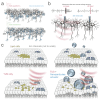The future of transcranial ultrasound as a precision brain interface
- PMID: 39471185
- PMCID: PMC11521279
- DOI: 10.1371/journal.pbio.3002884
The future of transcranial ultrasound as a precision brain interface
Abstract
Our understanding of brain circuit operations and disorders has rapidly outpaced our ability to intervene and restore them. Developing technologies that can precisely interface with any brain region and circuit may combine diagnostics with therapeutic intervention, expediting personalised brain medicine. Transcranial ultrasound stimulation (TUS) is a promising noninvasive solution to this challenge, offering focal precision and scalability. By exploiting the biomechanics of pressure waves on brain tissue, TUS enables multi-site targeted neuromodulation across distributed circuits in the cortex and deeper areas alike. In this Essay, we explore the emergent evidence that TUS can functionally test and modify dysfunctional regions, effectively serving as a search and rescue tool for the brain. We define the challenges and opportunities faced by TUS as it moves towards greater target precision and integration with advanced brain monitoring and interventional technology. Finally, we propose a roadmap for the evolution of TUS as it progresses from a research tool to a clinically validated therapeutic for brain disorders.
Copyright: © 2024 Murphy, Fouragnan. This is an open access article distributed under the terms of the Creative Commons Attribution License, which permits unrestricted use, distribution, and reproduction in any medium, provided the original author and source are credited.
Conflict of interest statement
We have read the journal’s policy and the author K.M. of this manuscript has the following competing interests: K.M. is a co-founder and shareholder of Attune Neuroscience.
Figures





Similar articles
-
Noninvasive intervention by transcranial ultrasound stimulation: Modulation of neural circuits and its clinical perspectives.Psychiatry Clin Neurosci. 2024 May;78(5):273-281. doi: 10.1111/pcn.13663. Epub 2024 Mar 20. Psychiatry Clin Neurosci. 2024. PMID: 38505983 Free PMC article. Review.
-
Modelling transcranial ultrasound neuromodulation: an energy-based multiscale framework.Acta Biomater. 2022 Oct 1;151:317-332. doi: 10.1016/j.actbio.2022.07.034. Epub 2022 Jul 25. Acta Biomater. 2022. PMID: 35902037
-
The intervention, the patient and the illness - Personalizing non-invasive brain stimulation in psychiatry.Exp Neurol. 2021 Jul;341:113713. doi: 10.1016/j.expneurol.2021.113713. Epub 2021 Mar 31. Exp Neurol. 2021. PMID: 33798562 Review.
-
Multi-modal investigation of transcranial ultrasound-induced neuroplasticity of the human motor cortex.Brain Stimul. 2022 Nov-Dec;15(6):1337-1347. doi: 10.1016/j.brs.2022.10.001. Epub 2022 Oct 11. Brain Stimul. 2022. PMID: 36228977
-
Effect of Low Intensity Transcranial Ultrasound Stimulation on Neuromodulation in Animals and Humans: An Updated Systematic Review.Front Neurosci. 2021 Apr 14;15:620863. doi: 10.3389/fnins.2021.620863. eCollection 2021. Front Neurosci. 2021. PMID: 33935626 Free PMC article.
Cited by
-
Diagnostic ultrasound enhances, then reduces, exogenously induced brain activity of mice.Front Hum Neurosci. 2025 Feb 11;18:1509432. doi: 10.3389/fnhum.2024.1509432. eCollection 2024. Front Hum Neurosci. 2025. PMID: 40007560 Free PMC article.
-
Novel NIBS in psychiatry: Unveiling TUS and TI for research and treatment.Brain Neurosci Adv. 2025 Mar 14;9:23982128251322241. doi: 10.1177/23982128251322241. eCollection 2025 Jan-Dec. Brain Neurosci Adv. 2025. PMID: 40092509 Free PMC article. Review.
-
Parameter optimisation for mitigating somatosensory confounds during transcranial ultrasonic stimulation.bioRxiv [Preprint]. 2025 Mar 19:2025.03.19.642045. doi: 10.1101/2025.03.19.642045. bioRxiv. 2025. Update in: Brain Stimul. 2025 Jul-Aug;18(4):1224-1236. doi: 10.1016/j.brs.2025.06.009. PMID: 40166137 Free PMC article. Updated. Preprint.
-
The promises and challenges of neurotechnology to improve human health and cognition.PLoS Biol. 2024 Oct 30;22(10):e3002903. doi: 10.1371/journal.pbio.3002903. eCollection 2024 Oct. PLoS Biol. 2024. PMID: 39475898 Free PMC article.
References
MeSH terms
LinkOut - more resources
Full Text Sources

